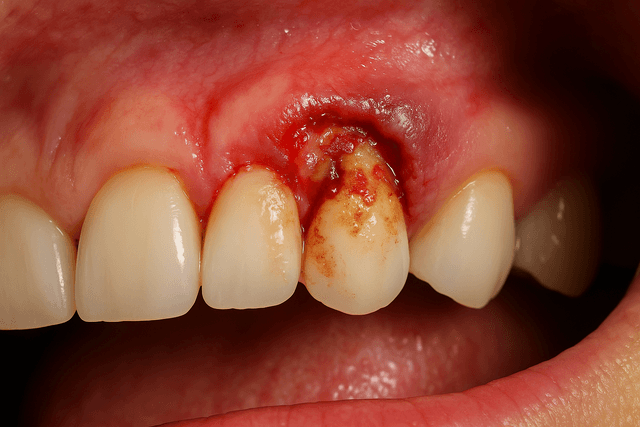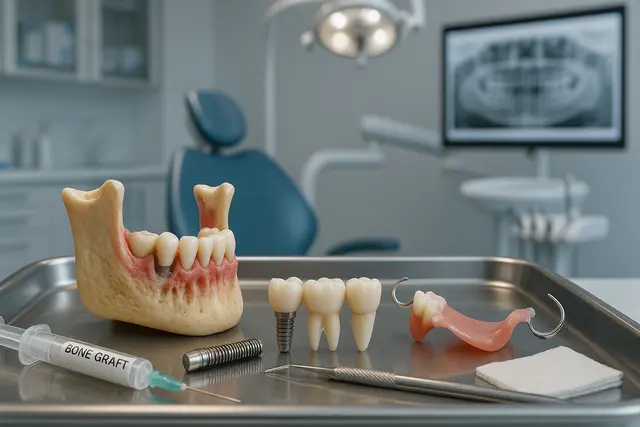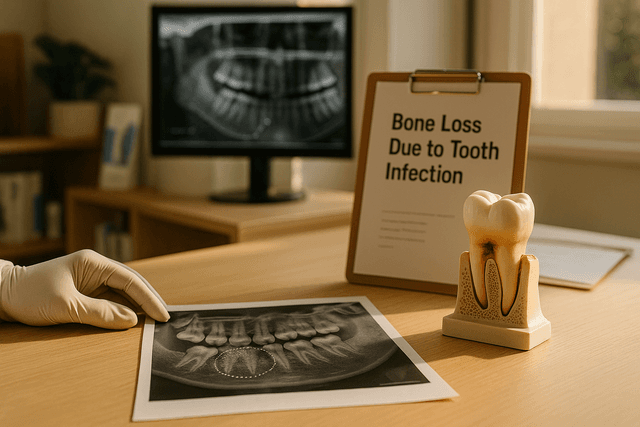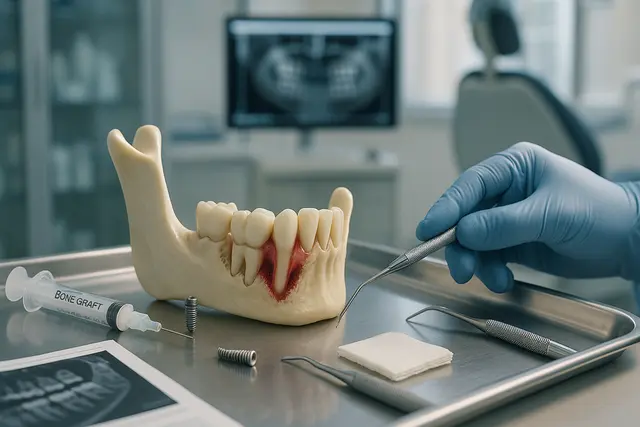Oral Health
6 min read
Jun 04, 2025
Recognizing Gum Graft Infection Signs: A Patient’s Guide
You’ve just had gum graft surgery and are doing your best to follow all the post-op instructions. But now you’re second-guessing every twinge, every bit of swelling, and that weird white spot that showed up out of nowhere. Is this part of the healing process, or is something wrong?

Let’s say you recently went through gum graft surgery. Maybe you did it to fix gum recession, protect your tooth roots, or finally feel less self-conscious about your smile. Either way, you survived the appointment, followed the care instructions, and started the healing process. All good, right?
Then something feels… off. Maybe it’s swelling that won’t quit. Maybe your breath smells worse than your gym socks. Or maybe there’s a weird white patch of tissue you swear wasn’t there yesterday. Whatever it is, your gut says: something’s wrong. You might be looking at the early signs of infection.
This guide will walk you through what’s normal, what’s not, and when it’s time to stop scrolling and call your dentist or periodontist.
Understanding the Gum
Gums are the unsung heroes of your mouth. These soft tissues hold your teeth in place, protect the roots, and create a barrier between your bloodstream and the bacteria hanging out in your mouth. When gum health starts to slide, whether from gum disease, injury, or age, it can lead to recession, exposing sensitive roots and throwing your smile out of balance.
That’s where a gum graft comes in.
What Is a Gum Graft?
A gum graft is a common dental procedure designed to restore lost gum tissue. In most cases, your periodontist will take tissue from the roof of your mouth or another source and attach it to the area where your gum has receded. There are different gum graft procedures, including the free gingival graft, which uses tissue from the palate, and connective tissue grafts, which are slightly more involved.
No matter the type, gum graft surgery is a dental fix meant to prevent tooth loss, protect against further gum recession, and improve your oral health. But like with any kind of surgery, things can go sideways.
When the Graft Becomes a Problem
Gum graft surgery doesn’t feel like a beach vacation. Swelling, a little bleeding, and mild discomfort are part of the healing phase. But when that pain doesn’t ease up, or when other red flags start waving, it could mean the graft isn’t healing properly.
Here are some common signs of a failed gum graft or possible infection:
Persistent pain or throbbing that doesn’t get better with time
Gum bleeding after the healing should be underway
A large patch of white tissue or a white patch of tissue that seems infected
Pus oozing from the graft site or around the graft
A sour or metallic taste that won’t go away
Swelling that keeps growing instead of shrinking
Sensitivity or spontaneous gum bleeding
Foul breath despite good oral hygiene
If you notice any of these symptoms, don’t wait it out. Contact your periodontist or dentist. Recognizing the signs early can make the difference between a successful gum graft and a failed one.
Graft Failure: What Does It Mean?
A failed gum graft can happen when the graft doesn’t integrate with your existing gum tissue or if the blood supply to the graft is cut off. No blood flow? No healing. This graft failure might show up as sloughing tissue, discoloration, or even graft shrinkage.
The signs of a failed gum graft aren’t always loud and obvious. Sometimes it’s a subtle color change or a sudden increase in gum sensitivity. The graft area might feel “loose,” or the gum graft looks like it’s pulling away.
Pay close attention during the first week. That’s when most complications show up. The phrase “gum graft one week later” should ideally conjure up images of mild tenderness, not bleeding and swelling or new pockets of pus.
Post-Surgery Healing: What’s Normal?
Let’s give some credit to your body here. The body’s natural healing response is usually amazing at fusing grafted tissue into place. The healing stages often look like this:
Days 1–3: Swelling, slight bleeding, discomfort
Days 4–7: Scabbing, tightening of the gum, mild pain
Week 2: Scabbing fades, graft begins blending with your natural gum tissue
Weeks 3–4: The graft heals into place, color evens out, sensitivity fades
Part of the healing process includes some inflammation. That’s okay. But pain and swelling that don’t go away, or worse, get more intense, can be a sign of graft failure symptoms or infection. Keep an eye out for a sign of graft failure like persistent bleeding or sudden changes in color or size around the graft site.
Keeping Your Dentist in the Loop
Your dental professional isn’t just there for the surgery. They’re part of your gum graft recovery team. Don’t hesitate to call if you feel unsure. A quick check-in can help prevent infection from turning into a full-blown failed gum graft.
And yes, there is such a thing as contacting them too late. Waiting until the pain becomes unbearable or the graft fails completely makes treatment more complicated. The goal is to save the graft before it’s too far gone.
How to Prevent Infection After Gum Graft Surgery
Let’s talk about what you can do to keep that graft safe and thriving. A successful gum graft is all about playing the long game. That means following your care instructions like a pro.
Here’s how to help prevent infection and promote proper healing:
Stick to soft foods like yogurt, mashed potatoes, and smoothies. Chewing directly on the gum graft? Big no.
Use a cold compress in the first 48 hours to minimize swelling.
Keep your head elevated while sleeping to avoid pressure buildup.
Follow all prescribed medications, especially if your periodontist decides to prescribe antibiotics.
Don’t skip dental visits. Your dentist needs to check the healing response and spot any trouble early.
Avoid brushing or flossing directly on the gum graft. Your team will let you know when it’s safe to resume regular oral hygiene in that area.
Say no to smoking or vaping. Nicotine cuts off blood supply and seriously raises your risk of graft failure.
Proper oral hygiene matters more than ever following gum graft surgery. A clean mouth is a healing mouth. But remember, good oral hygiene doesn’t mean scrubbing the graft area raw, it means being smart about how and where you clean.
What If the Graft Fails Anyway?
Sometimes, despite your best efforts, the graft fails. If this happens, your dentist will evaluate whether a second gum graft procedure is needed. Not all failed grafts require a redo, some can heal enough on their own to stabilize the gum.
If you end up needing additional graft procedures, your periodontist will likely adjust the approach to improve the odds of success. This might mean a different donor site, better support from surrounding gum tissue, or longer healing time before any dental implants or further oral surgery.
And hey, if you’re feeling frustrated or disappointed, that’s completely normal. Gum graft surgery is a dental procedure that takes time, patience, and follow-through. A hiccup doesn’t mean you’ve failed. It just means your gums need a bit more help getting where they need to go.
Recognizing the Signs, And Taking Action
The success of your gum graft hinges on how quickly you notice these symptoms and act. Whether it’s pain and swelling, bleeding after the healing phase, or a suspicious patch of white tissue, don’t wait for a dental emergency.
Call your gum specialist or dentist. Let them know what’s going on. They’d much rather see you early and keep things on track than try to save a graft that’s already failed.
Your Gums Deserve the Best
Gum graft surgery is a common dental procedure, but that doesn’t make it minor. It’s a big deal, for your comfort, your confidence, and your long-term oral health. Whether you’re on day one of healing or you’re two weeks in and wondering if that twinge is normal, stay aware and don’t be afraid to ask questions.
Your gums have a tough job, and this kind of support, both from your dental team and from yourself, is how they get back to doing it well.
Now, go easy on those soft foods, keep that graft clean, and remember: successful gum healing is a team effort.
What Are the Early Signs of Infection After Gum Graft Surgery?
Common early signs of infection include persistent pain, swelling that worsens, foul breath, a bad taste in your mouth, pus around the graft, and unusual white tissue patches. If any of these occur, contact your dentist or periodontist immediately to prevent further complications.
Is Some Discomfort Normal After a Gum Graft?
Yes, mild swelling, tenderness, and slight bleeding are normal during the first few days after surgery. However, pain that intensifies, lasts beyond a week, or is accompanied by other symptoms like pus or fever may indicate a problem and should be checked out.
How Can I Prevent Infection After Gum Graft Surgery?
Follow your post-op instructions closely: stick to soft foods, avoid brushing the graft site, take any prescribed antibiotics, use cold compresses for swelling, and don’t smoke or vape. These steps help protect the graft and support healthy healing.
What Happens If a Gum Graft Fails?
If a graft fails, your dentist may recommend a second procedure or monitor the area to see if partial healing occurs. Graft failure can result from poor blood supply, trauma, or infection. Early intervention often improves the chance of saving or redoing the graft successfully.
Read Next
Related Posts

Oral Health
Tooth Replacement Options to Prevent Bone Loss
Losing a tooth isn’t just about appearance, it can have a lasting impact on your oral health, jawbone strength, and overall quality of life. When teeth go missing, the jawbone begins to shrink, which can change your bite, your facial structure, and even your confidence. Fortunately, modern dentistry offers several effective solutions to replace missing teeth and prevent further bone loss.
4 min read
Sep 26, 2025

Oral Health
Bone Loss Due to Tooth Infection Explained: What It Means for Your Oral Health
A tooth infection isn’t just about pain, it can quietly damage the tissues around a tooth and even erode the jawbone that supports your smile. This guide explains how infections start, why they can lead to bone loss, the warning signs to watch for, and the treatments that can stop the spread and rebuild lost support.
5 min read
Sep 25, 2025

Oral Health
Understanding Bone Loss in Teeth: Causes and Treatments That Work
Bone loss in teeth is a silent threat that can compromise your smile, facial structure, and overall oral health. While it often goes unnoticed in the early stages, it can lead to serious consequences if left untreated. Understanding what causes dental bone loss, and how to prevent or manage it, is key to maintaining a strong, healthy foundation for your teeth.
5 min read
Sep 25, 2025
Don’t have time to research every dentist around you?
See why 30k+ patients trusted us